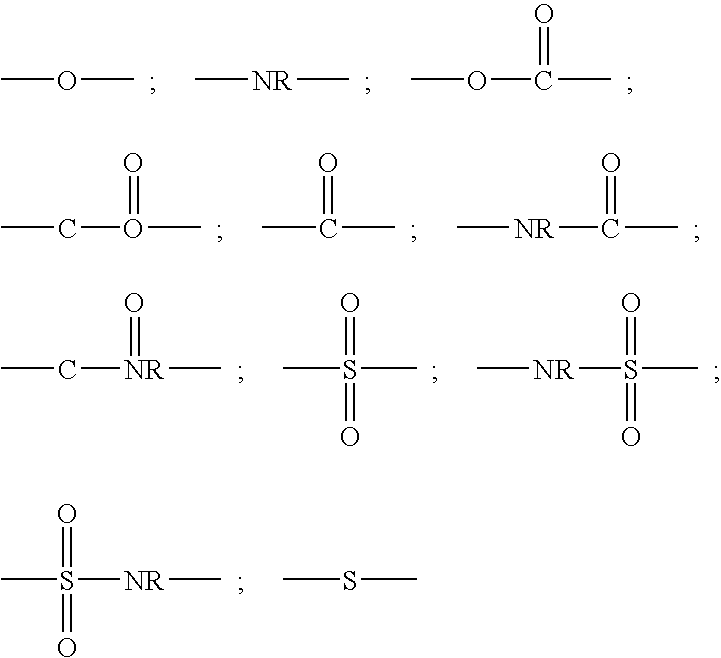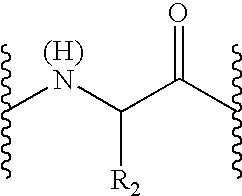Peptide inhibitors of hepatitis C virus NS3 protease
a technology of hepatitis c virus and peptide inhibitors, which is applied in the direction of tripeptides, dipeptides, tripeptide ingredients, etc., can solve the problems of hepatocellular carcinoma, hepatitis c virus and chronic hepatitis and cirrhosis of the liver
- Summary
- Abstract
- Description
- Claims
- Application Information
AI Technical Summary
Benefits of technology
Problems solved by technology
Method used
Image
Examples
example 1
Synthesis of Compound 1a: SEQ ID NO: 5 (Acetylated at its Amino Terminus)
i) (S)-tert-Butyl-2-amino-4,4-difluoro butanoate hydrochloride
Using the procedure described in example 3 (i) for the (R)-enantiomer, the title compound was obtained as an off-white powder; mp 152-153.degree. C. (MeOH, Et.sub.2 O, pentane); .alpha..sub.D +5.1.degree. (c=1.0, anhydrous MeOH). .sup.1 H-NMR (DMSO-d.sub.6) .delta. 1.44 (s, 9H), 2.36-2.50 (m, 2H), 4.05 (bs, 1H), 6.31 (tt, J=4.5, 55.6 Hz, 1H), 8.71 (bs, 3H); .sup.13 C-NMR (DMSO-d.sub.6) .delta. 27.3, 34.3 (t, J=23.3 Hz), 47.6, 83.5, 114.9 (t, J=238 Hz), 167.1; .sup.19 F-NMR (DMSO-d.sub.6) .delta. -114.4 (d, J=285 Hz), -115.2 (d, J=285 Hz); MS m / z 196 (M.sup.+ +H).
ii) (1a)
The protected pentapeptide shown below (ac-tert-butyl-asp-tert-butyl-glu-met-tert-butyl-glu-tert-butyl-glu) was employed in this example ##STR45##
30 mg pentapetide (0.03 mmol) was dissolved in dichloromethane (0.5 mL) and cooled to 0.degree. C. N-Ethyl, N'-(dimethylamino)propylcarbodi...
example 2
Synthesis of Compound 1b.sup.1
In this example, (S)-tert-butyl-2-amino-4,4-difluoro-butanoate hydrochloride (prepared as described in example 1, i)) was used in the preparation of the first diastereomer of compound 1b.
This example, and also examples 3, 4 and 5 below, employed the protected pentapeptide shown below (Ac-tert-butyl-asp-tert-butyl-glu-diphenylala-tert-butyl-glu-cyclohexyl-ala) ##STR46##
i) (1b.sup.1)
50 mg pentapetide (0.05 mmol) was dissolved in DMF (0.5 mL) and cooled to 0.degree. C. HATU and solid (S)-tert-butyl-2-amino-4,4-difluoro-butanoate hydrochloride were added, followed by 2,6-lutidine (0.024 mL, 0.2 mmol). The reaction was allowed to reach room temperature and stirred for 3 h. Analytical HPLC (gradient 1) indicated incomplete conversion of the pentapeptide (.about.30% remaining, RT 10.4 min, gradient 1, product 11.9 min). After another 2 h the mixture was taken into ethyl acetate (100 mL) and washed successively with 1 N HCl, (2.times.50 mL), saturated aqueous N...
example 3
Synthesis of Compound 1b.sup.2
i) (R)-tert.-Butyl-2-amino-4,4-difluoro-butanoate hydrochloride
1.5 g (10.78 mmol) of (R) 2-Amino-4,4-difluoro butanoic acid (prepared as described in Winkler et al, Synthesis 1419, 1996) was dissolved in aqueous half saturated Na.sub.2 CO.sub.3 (50 mL) and cooled to 0.degree. C. A solution of (benzyloxy-carbonyloxy)succinimide (2.69 g, 10.78 mmol) in dioxane (50 mL) was added dropwise over 30 min. The resulting suspension was stirred overnight at room temperature. After evaporation of the dioxane under reduced pressure, water (20 mL) and EtOAc (150 mL) were added. The aqueous phase was brought to pH 2 by addition of 1 N HCl, the organic phase was separated, washed with brine and dried. Evaporation gave 2.85 g (97%) of a colourless oil.
This material (950 mg; 3.55 mmol) was dissolved in dichloromethane (15 mL) and N,N'-isopropyl-O-tert-butyl isourea (1.42 g, 7.10 mmol) was added dropwise. The solution was brought to gentle reflux. After 8 h another 1.42 g...
PUM
| Property | Measurement | Unit |
|---|---|---|
| Molar density | aaaaa | aaaaa |
| Molar density | aaaaa | aaaaa |
| Molar density | aaaaa | aaaaa |
Abstract
Description
Claims
Application Information
 Login to View More
Login to View More - R&D
- Intellectual Property
- Life Sciences
- Materials
- Tech Scout
- Unparalleled Data Quality
- Higher Quality Content
- 60% Fewer Hallucinations
Browse by: Latest US Patents, China's latest patents, Technical Efficacy Thesaurus, Application Domain, Technology Topic, Popular Technical Reports.
© 2025 PatSnap. All rights reserved.Legal|Privacy policy|Modern Slavery Act Transparency Statement|Sitemap|About US| Contact US: help@patsnap.com



